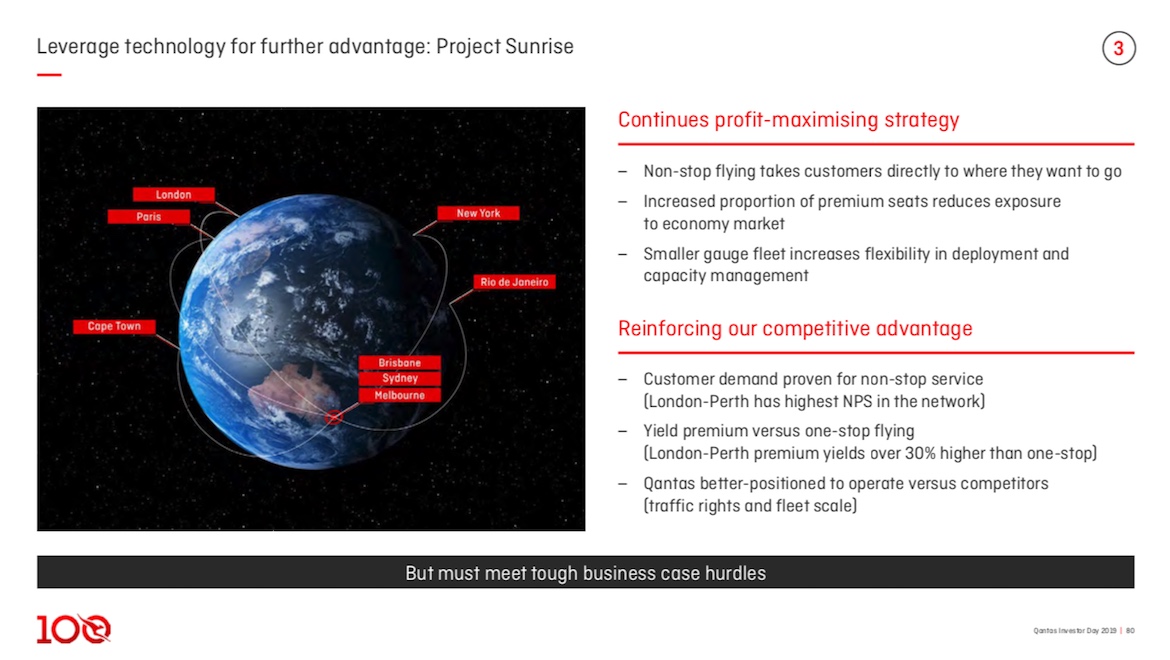
Qantas international chief executive Tino La Spina says the airline has asked Airbus and Boeing “to sharpen their pencils” on their Project Sunrise proposals.
Airbus has put forward its A350-1000 as the candidate aircraft for Qantas to mount nonstop flights from Australia’s east coast to London, New York and other ultra long-haul destinations currently being evaluated under the Project Sunrise banner.
The airline has said previously it hoped to reach a decision on whether to proceed with the project before the end of calendar 2019, with flights slated to begin in 2023 should the business case stack up.
Meanwhile, Boeing has proposed its 777-8X platform alongside an “interim solution” with an undisclosed aircraft type. The interim solution was proposed after Boeing pushed back the development timetable for the 777-8X, meaning the aircraft would not be in service by the time Qantas wanted to launch these ultra long-haul services.
Qantas said in August that Airbus and Boeing had submitted their best and final offers, following a request for proposal (RFP) process, that covered pricing, performance guarantees and details of potential delivery streams, among other matters.
The technical evaluation showed Airbus and Boeing could offer an aircraft that would be able to operate a full payload between Sydney and New York, Qantas chief executive Alan Joyce said earlier in 2019.
For Sydney-London, Joyce said the aircraft would not be able to operate with a full payload. Instead, the manufacturers told Qantas they were able to achieve a payload that made the business case potentially work.
La Spina said the further discussions with the manufacturers were about looking to make sure the aircraft were future proof.
“We’ve got the Airbus A350ULR and we’ve got the 777-X. Both products can do the mission,” La Spina said during Qantas’s investor day presentations in Sydney on Tuesday.
“The economics and what we have been asking from the manufacturers, we went through a best-and-final offer phase.
“We’ve asked them to go back and re-look at that, to sharpen their pencils, because there still was a gap there. We are still eagerly awaiting to see what we get back from that.”
“That is just not around price. That covers things like guarantees, the what ifs, because this aircraft is going to be in the fleet for the next 20 years and we want to cover off eventualities.”

Pilot with most to gain if Project Sunrise goes ahead: Qantas
In addition to securing the right deal from the aircraft manufacturer, Qantas has said previously the Project Sunrise business case also relied on discussions with the regulator on ultra long-haul duty hours and fatigue risk management, the right onboard products to secure a sufficient revenue premium over one-stop alternatives, and a new enterprise agreement with pilots.
“If one of those factors don’t click in we won’t do it,” Joyce said during the investor day.
On the matter of a new enterprise agreement with pilots, La Spina said the discussions with the pilots’ union was about productivity improvements.
“In no way are we asking any of our pilots to take a pay cut. We’re not doing that,” La Spina said.
“We are saying, ‘yes you might have to be more productive to get the same pay’. We’re not going to apologise for that. We’ve been doing that since we started transformation.”
Further, La Spina said pilots had the most to gain from the growth in the fleet that will follow from the introduction of new aircraft for these ultra long-haul flights.
La Spina noted that up until the arrival of the 787-9 in the Qantas fleet in 2017 the airline had first and second officers that were unable to achieve promotion because the captains above them were not retiring and not leaving the company.
“It is only through growth that you unlock new growth opportunities, promotion opportunities for our people,” La Spina said.
“If we get growth aircraft that means we need more pilots to fly. More pilots to fly means we get more, let’s call it, from the street, which create a ripple effect through the organisation as you start to promote pilots.
“A promotion for a pilot is the biggest payrise they are going to get in their career.”
Qantas domestic chief executive Andrew David told the investor day that prior to the introduction of the 787-9 the airline group was training about 200 pilots a year to cover retirements and pilot movements.
Over the past two years, that figure had increased to 500 pilots a year.
Australian and International Pilots Association (AIPA) president Mark Sedgwick has said pilots were supportive of Project Sunrise. AIPA is the union representing Qantas pilots.
“We think the value to Qantas and the strategic benefit goes beyond this pilot EBA negotiation,” First Officer Sedgwick said earlier in 2019.
“Obviously we are willing to negotiate and discuss how they feel our contract may assist, but the strategic benefit to Qantas is clear and transcends the pilot contract in itself.”











